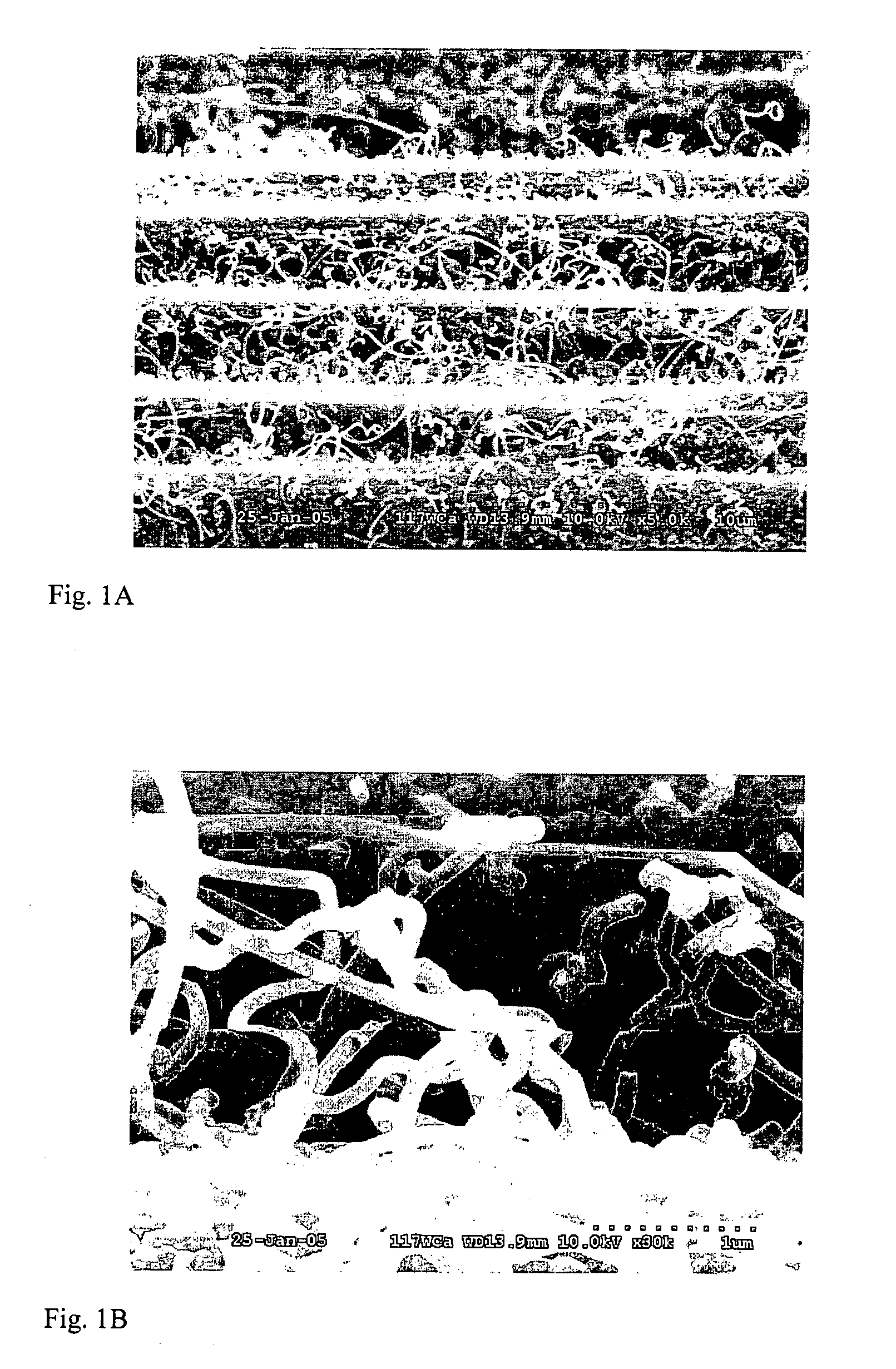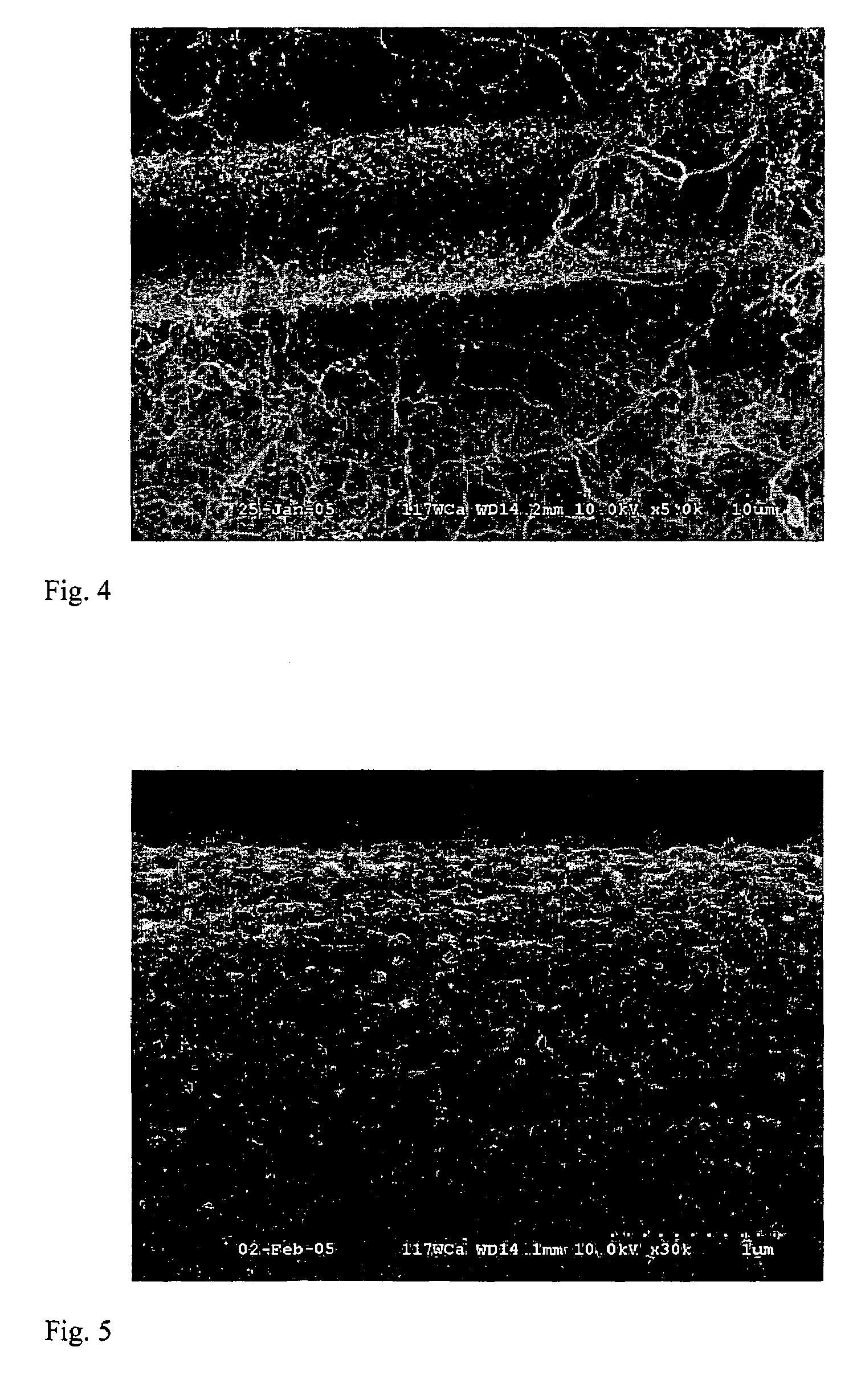Vapor grown carbon fiber reinforced composite materials and methods of making and using same
a carbon fiber reinforced composite material and vapor growth technology, applied in the field of new continuous fiber composite materials, can solve the problems of inability to discuss or use the production method of vgcf on continuous carbon, inability to manufacture nanofiber reinforced preforms, and inability to meet the requirements of nanofiber reinforced preforms, etc., to achieve the effect of improving stiffness, strength, fracture toughness and yield
- Summary
- Abstract
- Description
- Claims
- Application Information
AI Technical Summary
Benefits of technology
Problems solved by technology
Method used
Image
Examples
example 1
Carbon Fiber Textile Infusion with VGCF
[0045]A piece of plain weave polyacrylonitrile (PAN) carbon fiber cloth was desized by solvent wash with toluene and acetone followed by oven drying. The sample was then immersed in a 125 mM solution of ferric nitrate in ethanol, and dried at 80° C. and placed in a 50 mm tube furnace. The tube furnace was immediately heated to 800° C. and nitrogen flow of 90 sccm was started when the tube furnace temperature reached 100° C. After 15 minutes at 800° C. 5 sccm of acetylene was started and the nitrogen flow was reduced to 75 sccm. After 60 minutes the acetylene was turned off and the oven was cooled to 200° C. under nitrogen flow of 75 sccm. SEM images of the resulting VGCF infused preform are shown in FIGS. 1A and 1B. In FIG. 1A, the continuous carbon fibers of the preform are clearly visible with the mass of entangled VGCF infused into the preform. In FIG. 1B at higher magnification, the morphology of the well-formed VGCF are shown fused to the ...
example 2
Carbon Fiber Textile Infusion with VGCF
[0046]A piece of plain weave PAN carbon fiber cloth was desized by solvent wash with toluene and acetone followed by oven drying. The sample was then immersed in a 100 mM solution of ferric nitrate in ethanol, and dried at 80° C. The sample was then heated at 300° C. for 30 hours in an air convection oven, cooled, and placed in a 50 mm tube furnace. The tube furnace was heated to 750° C. and when it reached 600° C. nitrogen flow of 90 sccm was started. After 15 minutes at 750° C. 5 sccm of acetylene was started and the nitrogen flow was increased to 250 sccm. After 60 minutes the acetylene was turned off and the oven was cooled to 200° C. under nitrogen flow of 90 sccm. An SEM image of the resulting VGCF infused preform is shown in FIG. 2. In FIG. 2, the continuous carbon fibers of the preform are clearly visible with the mass of entangled VGCF infused into the preform.
example 3
Carbon Fiber Textile Infusion with VGCF
[0047]A piece of plain weave PAN carbon fiber cloth was desized by solvent wash with toluene and acetone followed by oven drying. The sample was then immersed in a freshly prepared 100 mM solution of ferric nitrate in ethanol, and dried at 80° C. The sample was then heated at 300° C. for 30 hours in an air convection oven, cooled, and placed in a 50 mm tube furnace. The tube furnace was heated to 750° C. and when it reached 600° C. nitrogen flow of 90 sccm was started. After 15 minutes at 750° C. 5 sccm of acetylene was started and the nitrogen flow was increased to 250 sccm. After 60 minutes the acetylene was turned off and the oven was cooled to 200° C. under nitrogen flow of 90 sccm. An SEM image of the resulting VGCF infused preform is shown in FIG. 3. In FIG. 3, the continuous carbon fibers of the preform are obscured by the high yield dense growth mass of entangled VGCF infused into the preform.
PUM
| Property | Measurement | Unit |
|---|---|---|
| Temperature | aaaaa | aaaaa |
| Temperature | aaaaa | aaaaa |
| Temperature | aaaaa | aaaaa |
Abstract
Description
Claims
Application Information
 Login to View More
Login to View More - R&D
- Intellectual Property
- Life Sciences
- Materials
- Tech Scout
- Unparalleled Data Quality
- Higher Quality Content
- 60% Fewer Hallucinations
Browse by: Latest US Patents, China's latest patents, Technical Efficacy Thesaurus, Application Domain, Technology Topic, Popular Technical Reports.
© 2025 PatSnap. All rights reserved.Legal|Privacy policy|Modern Slavery Act Transparency Statement|Sitemap|About US| Contact US: help@patsnap.com



